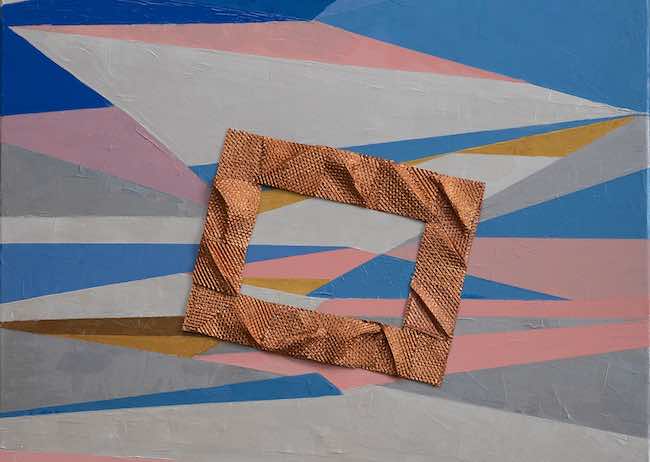Il distacco dalla forma osservata nella realtà costituisce ancora oggi un modo per andare ad approfondire ed esplorare quell’interiorità troppo confusa e nascosta per essere in grado di emergere laddove l’estetica e l’attinenza a ciò che lo sguardo è abituato a vedere quotidianamente siano preponderanti; perché in fondo l’animo ha bisogno di fuoriuscire liberamente trasformando i colori in parole e l’indefinitezza in espressione di pensieri in grado di fluire senza alcuno schema esecutivo. Ricorrere all’astrazione diviene dunque una scelta necessaria ad alcuni artisti per permettere alle idee e alla naturale inclinazione comunicativa di poter emergere. La protagonista di oggi non solo compie il percorso di allontanamento dall’immagine conosciuta, ma successivamente la reintroduce sotto forma di elemento materico utilizzando metalli la cui tecnica esecutiva è un suo personale brevetto.
Nel momento in cui gli artisti di inizio Novecento decretarono la fine delle regole accademiche così come tradizionalmente rispettate fino a qualche decennio prima, si compì una vera e propria spaccatura tra vari movimenti che tendevano a dare una propria personale interpretazione a quella rivoluzione epocale secondo la quale tutto l’equilibrio estetico, la fedeltà alla realtà osservata e la necessità di restare attaccati alla figurazione non aveva più senso, decadendo per lasciar emergere un modo diverso di intendere l’opera d’arte e l’approccio plastico all’esecuzione di un dipinto o di una scultura. Tutto ciò che era fondamentale per quel gruppo di creativi era sottolineare la supremazia del gesto creativo fine a se stesso, persino distante da qualsiasi soggettività che avrebbe intaccato quell’equilibrio plastico che non necessitava di essere intriso di emozioni, sensazioni, immagini, per potersi definire arte. Il De Stijl e il Suprematismo furono i primi movimenti a tendere verso la geometricità, il rigore di forme definite e accompagnate solo da colori primari necessari a sottolineare l’estraneità di un dipinto a tutto ciò che si avvicinava a quanto potesse essere osservato nella quotidianità; le forme oblique e irregolari di Kasimir Malevic si opponevano a quelle rigorosamente limitate al quadrato e al rettangolo di Piet Mondrian sebbene entrambi sottolineassero l’esigenza, emergente a seguito di un’osservazione più approfondita, di prendere le distanze dalle nuove forme di riproduzione delle immagini, come la fotografia, e dalle devastazioni visive della Prima Guerra Mondiale che coinvolse l’intera Europa. La freddezza e la limitatezza delle opere di Mondrian e di Theo Van Doesburg, che non seppero superare i limiti di quel tipo di arte, evolverono poco dopo nell’Astrattismo Geometrico che ampliò le possibilità formali anche alle linee oblique e ad altre forme come il triangolo e il cerchio, ma soprattutto introdusse una maggiore gamma cromatica fatta di tinte a volte più tenui, come nelle opere di Manlio Rho e Mario Sironi, altre invece più vivaci e intense, come in Mauro Reggiani e Luigi Veronesi. L’avvento dei successivi Informale Materico ed Espressionismo Astratto ruppero quelle regole geometriche e reintrodussero il caos, il contatto con l’interiorità, con il sentire profondo dell’esecutore dell’opera introducendo nell’Astrattismo una dimensione nuova, più a contatto con l’osservatore che si sentiva coinvolto in maniera istintiva e impulsiva senza che venisse chiamata in causa la sua parte razionale come avveniva invece con le correnti pittoriche finora citate. L’artista romana Maria Rita Onofri appartiene indiscutibilmente all’Arte Informale, inizialmente più espressionista astratta per poi giungere, nella fase creativa attuale, a un Astrattismo Geometrico Materico dove la materia diviene anche elemento figurativo, seppur mantenendo le caratteristiche stilizzate più vicine all’Espressionismo.
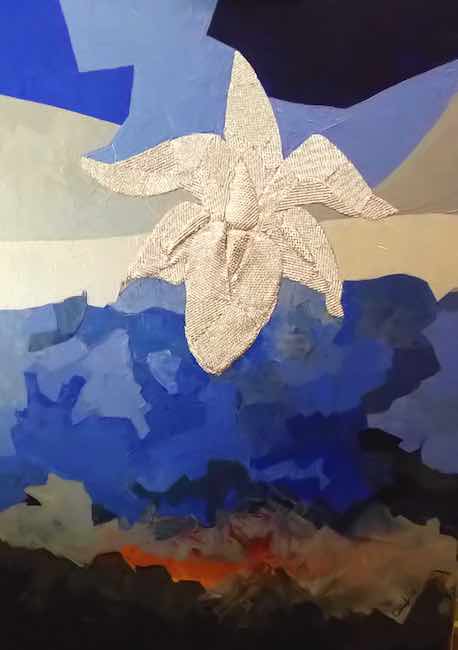
La sua formazione come orafo con le relative specializzazioni, professione che ha esercitato per molti anni, l’ha spinta a fondere l’amore per il colore che le aveva trasmesso la madre, anch’ella pittrice, e quella per la scultura, ritenendo la tela limitante a causa della bidimensionalità, e l’approccio scultoreo con il metallo, materiale per lei facilmente plasmabile, troppo distante dalla necessità di esprimersi attraverso una gamma cromatica vivace e ampia.
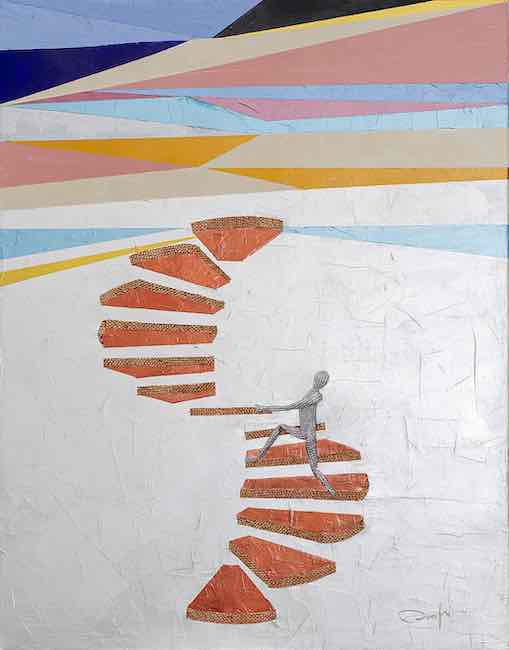
Così sceglie di dare vita a qualcosa di nuovo, uno stile unico in cui mescola le sue conoscenze in campo cromatico, la sua sapienza nel plasmare i metalli e infine un approccio geometrico e informale che esalta e al tempo stesso definisce i concetti che, di opera in opera, affronta. Le tonalità sono morbide, pastello, delicate tanto quanto lo è il desiderio della Onofri di mantenere il contatto con una realtà che non può sussistere se non attraverso lo specchio emozionale dell’esecutore tanto quanto dell’osservatore che vi si riflette e si ritrova, e che poi si materializza in alcuni dettagli più solidi, consistenti, come se costituissero quegli accenti imprescindibili per permettere di mettere in evidenza il fulcro del pensiero, della considerazione che costituisce la scintilla di partenza per la realizzazione dell’opera.
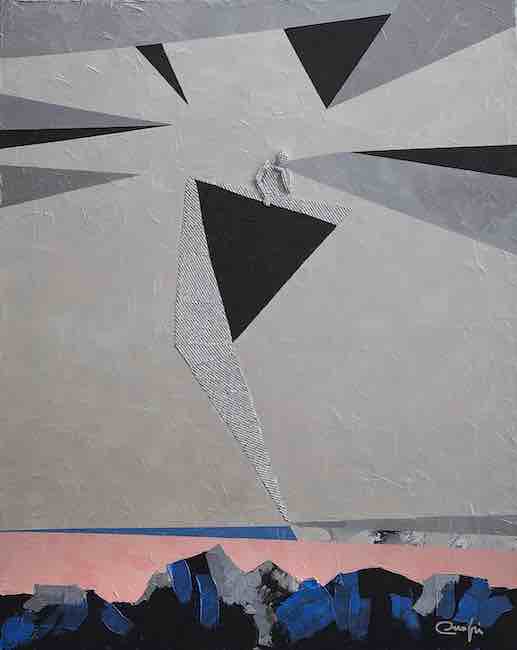
Ciò che rende maggiormente uniche le tele di Maria Rita Onofri, è una particolare tecnica di lavorazione dei metalli, da lei brevettata, che inserisce all’interno delle opere sotto forma di sottili lastre che vanno a rompere l’equilibrio cromatico e a enfatizzare ciò che è necessario emerga; l’intreccio della lavorazione contribuisce a infondere un’apparenza di leggerezza ai materiali usati e cioè lastre di alluminio, rame e ottone che rendono lucenti alcune parti dell’opera.
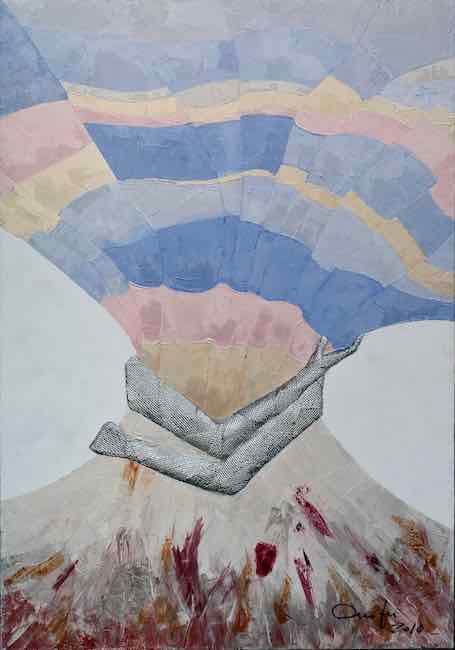
In Abbraccio cielo-terra, l’artista sembra voler raccontare la magia di un’unione che appartiene alla natura e che evoca l’impossibilità per i due elementi di fondersi insieme, costantemente vicini l’uno all’altro eppure eternamente separati; nella tela l’elemento metallico è utilizzato per raccontare le braccia dei due amanti impossibili, quasi come se nella romantica linea dell’orizzonte potessero solo sfiorarsi dando vita all’esplosione di emozioni che fuoriesce dalla cima della montagna come una colata lavica. Le tonalità sono delicate e tenui tanto quanto l’alluminio intrecciato rifrange la luce per evidenziare la preziosità del sentimento che fuoriesce dall’opera.
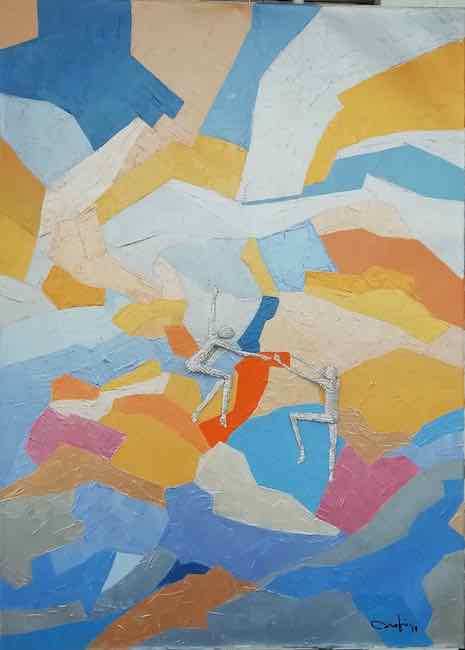
La natura sognante di Maria Rita Onofri si svela forse ancor più in Dentro il sogno, dove due personaggi stilizzati e piccoli rispetto al resto della composizione, danzano all’interno di un mondo sereno, felice, ideale, proprio perché hanno avuto il coraggio di credere in quel sogno, di scegliere di non tirarsi indietro o lasciarsi fermare dagli ostacoli orientando così la loro vita verso la dimensione desiderata. Si nasconde la metafora dell’esistenza contemporanea in questo lavoro, quell’esortazione da parte dell’artista a inseguire i propri desideri, le proprie inclinazioni perché è solo attraverso quell’atto temerario che è possibile raggiungere la piena realizzazione di sé e l’appagamento che la maggior parte delle persone continua a cercare per tutta la vita senza comprendere che la chiave per raggiungerli è proprio quella di ascoltarsi e poi agire affinché tutto possa diventare realtà.
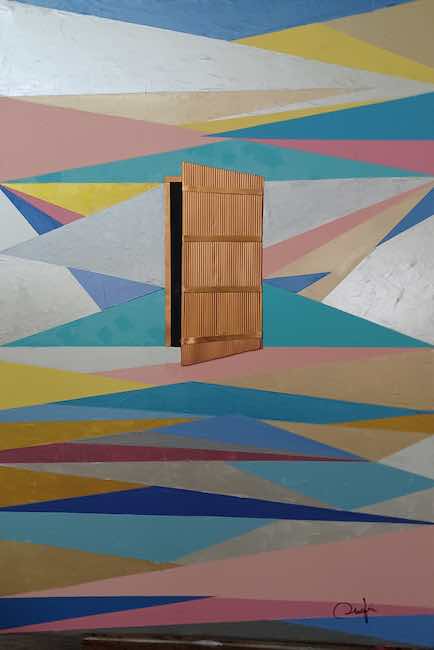
Il medesimo tema, quello di aprirsi alle possibilità, al cogliere le opportunità che si presentano e credere che i pensieri possano materializzarsi e trasformarsi in realtà, è protagonista dell’opera Una porta nel cielo la quale rappresenta quel simbolo esistenziale che permette di compiere un profondo cambiamento; lasciando la porta socchiusa si resta inevitabilmente all’interno di ciò che si conosce, rassicurante ma in un certo senso statico, aprendola invece si può lasciare alle energie nuove di entrare e dare uno scorcio verso altre opzioni, verso inediti percorsi che in ogni caso condurrebbero verso l’evoluzione. Il cielo rappresenta la positività, quel suggerimento da parte della Onofri che se anche si accettasse il rischio di aprirla quella porta, l’individuo continuerebbe a essere supportato dalle sue esperienze, dalle conoscenze acquisite e da quell’equilibrio che gli permetterebbe di mantenere il suo centro pur aprendosi a quel qualcosa di imprevisto e forse proprio per questo stimolante.
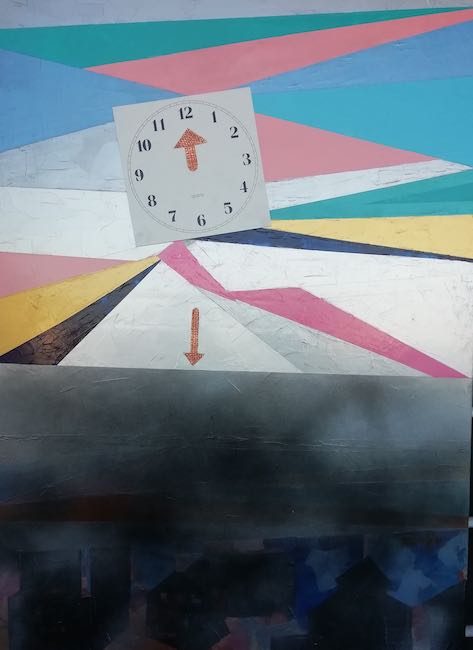
Nel lavoro Il tempo è scaduto l’artista sembra di contro esortare l’osservatore a non lasciare che gli istanti e le circostanze si susseguano senza essere in grado di viverli appieno perché poi, una volta che quel tempo infinito che credeva di avere giungerà al termine, potrebbe trovarsi a rimpiangere avvenimenti e persone che non è stato capace di apprezzare con pienezza a causa dell’inconsapevolezza dello scorrere della vita. Maria Rita Onofri da diversi anni ha deciso di dedicarsi completamente all’arte partecipando a molte mostre collettive, è stata inserita in diverse edizioni del Catalogo dell’Arte Moderna Giorgio Mondadori e attualmente è in corso una sua minipersonale che terminerà il 6 gennaio presso Villa Borromeo di Arcore.
MARIA RITA ONOFRI-CONTATTI
Email: mariaritaonofri@gmail.com
Sito web: http://www.mariaritaonofri.it/
Facebook: https://www.facebook.com/mariaritaonofri
Instagram: https://www.instagram.com/mariaritaonofri/
The poetic encounter between matter and colour in the unique and original artistic style of Maria Rita Onofri
Detachment from the form observed in reality is still today a way to go deeper and explore that interiority that is too confused and hidden to be able to emerge where aesthetics and relevance to what the eye is accustomed to seeing on a daily basis are preponderant; because after all, the soul needs to escape freely, transforming colours into words and indefiniteness into the expression of thoughts that can flow without any executive scheme. Resorting to abstraction thus becomes a necessary choice for some artists to allow ideas and natural communicative inclination to emerge. Today’s protagonist not only makes the journey away from the known image, but subsequently reintroduces it in the form of a material element using metals whose execution technique is her own personal patent.
At the moment when the artists of the early 20th century decreed the end of the academic rules as traditionally respected until a few decades earlier, a real split took place between various movements that tended to give their own personal interpretation to that epochal revolution according to which all aesthetic balance, fidelity to observed reality and the need to remain attached to figuration no longer made sense, decaying to allow a different way of understanding the work of art and the plastic approach to the execution of a painting or sculpture to emerge. All that was fundamental for that group of creatives was to emphasise the supremacy of the creative gesture as an end in itself, even distant from any subjectivity that would undermine that plastic balance that did not need to be imbued with emotions, sensations, images, in order to be defined as art. De Stijl and Suprematism were the first movements to tend towards geometricity, the rigour of defined forms accompanied only by primary colours necessary to emphasise the extraneousness of a painting to anything that approached what could be observed in everyday life; Kasimir Malevic’s oblique and irregular forms were opposed to those strictly limited to the square and rectangle of Piet Mondrian, even though both emphasised the need, which emerged upon closer observation, to distance themselves from the new forms of image reproduction, such as photography, and from the visual devastation of the First World War that involved the whole of Europe.
The coldness and narrowness of the artworks of Mondrian and Theo Van Doesburg, who were not able to overcome the limitations of that type of art, evolved shortly afterwards into Geometric Abstractionism, which extended the formal possibilities to oblique lines and other forms such as the triangle and the circle, but above all introduced a greater chromatic range made up of colours that were sometimes softer, as in the artworks of Manlio Rho and Mario Sironi, and sometimes brighter and more intense, as in Mauro Reggiani and Luigi Veronesi. The advent of the subsequent Material Informalism and Abstract Expressionism broke these geometric rules and reintroduced chaos, contact with the interiority, with the profound feeling of the artist, introducing a new dimension into Abstractionism, more in contact with the observer who felt involved in an instinctive and impulsive manner without stimulating his rational side as was the case with the aforementioned pictorial currents. The Roman artist Maria Rita Onofri unquestionably belongs to Informal Art, which was initially more abstract expressionist to then reach, in its current creative phase, a Geometric-Material Abstractionism where matter also becomes a figurative element, although maintaining the stylised characteristics closer to Expressionism. Her training as a goldsmith with the related specializations, a profession she practiced for many years, prompted her to merge the love for color that her mother, also a painter, had passed on to her, and that for sculpture, a limiting canvas due to its two-dimensionality, and the sculptural approach with metal, a material that is easily malleable for her, too distant from the need to express herself through a lively and wide chromatic range. So she chooses to give life to something new, a unique style in which she mixes her knowledge of colour, her skill in shaping metal and finally a geometric and informal approach that enhances and at the same time defines the concepts that, from work to work, she addresses.
The tones are soft, pastel, delicate, as is Onofri’s desire to maintain contact with a reality that can only exist through the emotional mirror of the executor as much as of the observer who reflects and finds himself in it, and which then materialises in some more solid, consistent details, as if they constituted those essential accents to allow the fulcrum of thought, of the consideration that constitutes the starting spark for the realisation of the work, to be highlighted. What makes Maria Rita Onofri’s canvases even more unique is a particular metalworking technique, patented by her, which she inserts inside the works in the form of thin sheets that break the chromatic balance and emphasise what needs to emerge; the interweaving of the work contributes to instil an appearance of lightness in the materials used, namely aluminium, copper and brass sheets that make certain parts of the artwork shine. In Sky-Earth Embrace, the artist seems to want to recount the magic of a union that belongs to nature and evokes the impossibility for the two elements to merge together, constantly close to each other yet eternally separated; in the canvas, the metal element is used to tell the story of the arms of the two impossible lovers, almost as if in the romantic line of the horizon they could only brush against each other, giving life to the explosion of emotions that comes out of the mountaintop like a lava flow. The tones are as delicate and subtle as the woven aluminium refracts the light to highlight the preciousness of the sentiment that emanates from the work. Maria Rita Onofri’s dreamy nature is perhaps revealed even more in Inside the dream, where two stylised characters, small in comparison to the rest of the composition, dance within a serene, happy, ideal world, precisely because they have had the courage to believe in that dream, to choose not to back down or let obstacles stop them, thus directing their lives towards the desired dimension.
The metaphor of contemporary existence is hidden in this work, that exhortation on the part of the artist to pursue one’s desires, one’s inclinations because it is only through that reckless act that it is possible to achieve full self-realisation and the fulfilment that most people continue to seek throughout their lives without realising that the key to achieving them is precisely that of listening to oneself and then acting so that everything can become reality. The same theme, that of opening oneself up to possibilities, seizing the opportunities that present themselves and believing that thoughts can materialise and become reality, is the protagonist of the artwork A Door in the Sky, which represents that existential symbol that allows a profound change to take place; leaving the door ajar one inevitably remains within what one knows, reassuring but in a certain sense static, while opening it can allow new energies to enter and give a glimpse towards other options, towards new paths that in any case would lead towards evolution. The sky represents positivity, Onofri’s suggestion is that even if one were to accept the risk of opening that door, the individual would continue to be supported by his experiences, by the knowledge he has acquired and by that balance that would allow him to maintain his centre while opening up to that something unexpected and perhaps precisely for this reason stimulating. In the artwork Il tempo è scaduto Time has expired, the artist seems, on the other hand, to exhort the observer not to let instants and circumstances follow one another without being able to live them to the full because then, once that infinite time he thought he had comes to an end, he might find himself regretting events and people he was not able to fully appreciate due to his unawareness of the passing of life. For several years now, Maria Rita Onofri has decided to devote herself completely to art, taking part in many group exhibitions. She has been included in several editions of the Catalogo dell’Arte Moderna Giorgio Mondadori and is currently holding a mini-personal exhibition that will end on 6 January at Villa Borromeo in Arcore.


